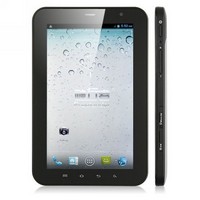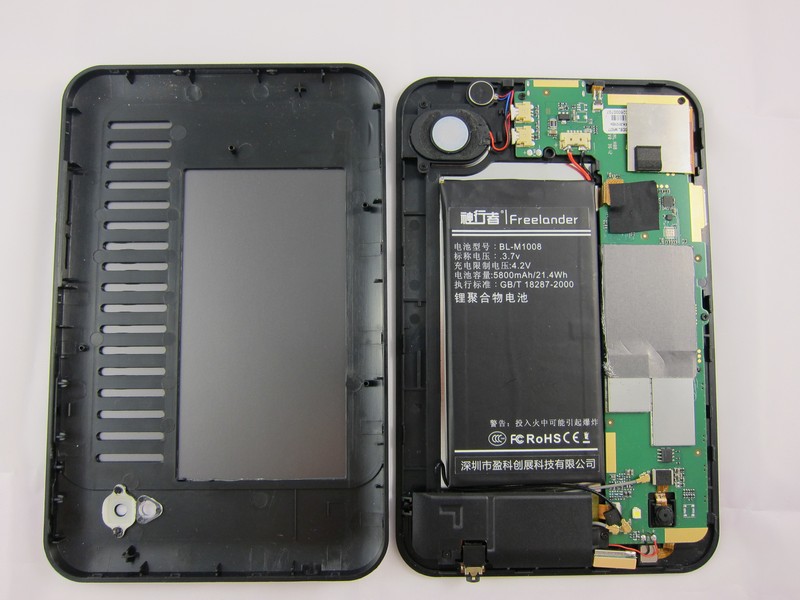Review of the tablet Freelander PD10 Typhoon - "full stuffing" at a reasonable price

Chinese manufacturers are constantly increasing production capacity. But, in fact, devices in one segment (7, 8, 9.7, 10.1 inches) on the same platform are of the same type. Practically the same characteristics with a difference in price. Over time, it bothers and you want something really new and interesting.
For me, the novelty was brought by the tablet of the Chinese company Freelander, which has recently been engaged in the production of car navigators on the tablet market.
It all started with a PD10 tablet on a Telechips 8923 chip: 7 inches, a weak screen with a resolution of 800x480, but there was a built-in GPS module. And then they launched a lot of new modifications under the same name PD10, but with different consoles. There was a version with built-in TV, then a version with built-in 3G and GPS on the MTK6575 chip with a better screen (1024x600), but 512MB of memory. Then came a modification with 1GB of memory. And the peak of this development was the Freelander PD10 Typhoon tablet on the MTK6577 chip, which we will consider in this review.
Specifications
Screen: 7 inches, 1024x600 IPS, multi-touch 5 points
Chip: MTK6577
Processor: Cortex-A9, dual-core 1 GHz
Video accelerator: PowerVR SGX531
RAM: 1GB (LPDDRⅡ)
ROM: 4GB
Camera: front 2.0 MP, rear 2.0 MP
GPS: yes
Bluetooth: yes
WIFI: 802.11 b / g / n
3G: built-in, one SIM card
Network:
GSM 850/900/1800 / 1900MHz
WCDMA: 900 / 2100MHz
Battery: 5200mAh
In fact, PD10 Typhoon is built on the “telephone” chip Mediatek MT6577 .
A distinctive feature of other tablets is its integrated 3G module and GPS module. Also, compared to the previous version on MTK6575, in which there were 2 SIM card slots, the PD10 Typhoon has only 1 SIM card slot for working in GSM or WCDMA standards.
Packaging and equipment
White cardboard box with the MID inscription on the front and a sticker with a brief description of the characteristics on the back:


Tablet and accessories in different compartments:

Standard equipment includes: charger, USB cable, headset, manual in English. The manual does not even describe the technical specifications. Not knowing in advance the appearance of the tablet, it is very difficult to guess that the model you ordered was sent to you.

5V / 2A charger and USB cable. The USB cable is not an ordinary microUSB-USB, but a 30-pin-USB. A very strange decision.


Headset without identification marks:

Additionally, there were orders:
Car charger (USB):


Universal glass mount:

Universal case:


The tablet holds pretty well, but with this insert (touch buttons below) it can slip out:

Using Velcro, the case turns into a stand:

Appearance
PD10 Typhoon really wants to look like a smartphone with its appearance. A metal insert is used at the back for better heat dissipation. I got an aesthetic option with a gray insert (it also happens with white).


The first thing you notice is the backlit touch buttons: The

volume buttons are recessed into the case, which affects the usability of the

headphone jack and microphone:

2 speakers are built-in: one is located on the bottom at the end, the second on the front:


30-pin connector for USB cable connection:

SIM card slot and microSD card slot:

If a microSD card can be inserted without additional funds, then a SIM card cannot. The latch is fixed very deeply, you need to resort to using a thin ruler or plastic card to pin down the SIM card. The same situation occurs during extraction.
The tablet can be held in one hand. But due to the large weight of 398 grams, this is not very convenient.


The thickness is 11mm.
Camera
2MP front camera: 2MP

rear camera:

There is a flash, but the brightness is very low, poorly suited even for use as a flashlight.
The quality of the photo is very average, but in Skype, the front camera looks fine. Definitely better than 0.3MP.
Sound
The sound is loud, but when held horizontally, one speaker is often blocked by a finger.
Wifi
Wifi signal strength is good, support for the standard up to 802.11n is declared, but, unfortunately, it was possible to check only on a router with support for 802.11g standard.

Screen
7-inch IPS screen with a resolution of 1024x600. The screen is really bright, a set brightness of 50% is enough to work during the day.


Viewing angles:




Web browsing
A very large LCD Density parameter (240) is set in the standard firmware, because of this, viewing pages is not very convenient. This parameter can be reduced to 160 using the LCD Density Modder utility (requires Root).
Pages open quickly, Flash is supported.

Video
It supports video playback in various formats. MTK6577 chip performance is not enough to watch movies in FULL HD.
OS
Android 4.0.4 is installed in the PD10 Typhoon:




After changing the LCD Density parameter, the native launcher practically fails, you need to use another one. For example, Go Launcher.
Hardware
The “telephone” chip MTK 6577 is installed in the tablet. The architecture of which is based on a dual-core Cortex-A9 processor with a frequency of up to 1.2 GHz, PowerVR 531 is used as a GPU. Perhaps this video accelerator is not so powerful, but it copes well with games.
Antutu 3.0.2:


Quadrant:




Linpack:


Working hours
The operating time was estimated by the synthetic tests Antutu Tester and Nova Battery Tester:


For comparison, the Ainol Fire tablet with a 5000mAh battery scored 488 points in Antutu Tester.
Theoretically, a tablet tablet can work for about 6-6.5 hours under load.
Disassembly
The tablet disassembles quite simply. 2 screws are unscrewed and using a plastic card around the perimeter we open the latches.

General view:

The first thing that catches your eye is the marking on the battery. Yes, it says 5800mAh! Despite the fact that according to official information, a 5200mAh battery is installed. Perhaps a different specification is indicated under the sticker.
Battery thickness:

According to the size of the battery (11.3x5.3cm) it is difficult to say what the real capacity is. But it seems that it is he who gives the total weight of the tablet to almost 400 grams.
GPS
Satellites are caught confidently. On the left is the tablet on the windowsill, on the right in the car: The


suction cups on the car mount are quite powerful, the quality of the plastic is also pleasing, when shaking it should not break under the weight of the tablet. It is best to mount the tablet in the center, if the torpedo interferes with the tablet to the left of the driver, it reduces the visibility of the driver. I fasten my old 5-inch navigator on the left (the review does not obstruct), in my opinion this arrangement is less distracting from the road, the central location is more suitable for trips with a “navigator”.


In the photo, Google maps are open, which do not display my location.
3G
The tablet is tested on the operators Life (2G) and Ukrtelecom (3G UMTS-2100MHz)
There are all kinds of settings for working in modem mode and choosing your preferred network (GSM / WCDMA).


It works in phone mode with or without a headset. The opponent’s audibility is a little dull (perhaps it can be fixed in the engineering menu), the microphone works well, no noise is observed.
The interface is normal, as in any Android smartphone:


Of the problems found: the tablet can sometimes stop seeing the SIM card for no apparent reason, it can only be treated by rebooting.
Firmware and Root Access Permissions
New firmware could not be found. Root access rights can be obtained in the following way:
1. Install the program
2. Turn on USB debugging in the tablet’s settings and connect the tablet using a USB cable to the computer.
3. Run the program, wait until the tablet is determined. Select the 4th icon from the top:


4. Select the icon where the word Root is present in the name. Click "Next" and wait.


Done!
By simultaneously pressing the Volume + and Power buttons, you can go into Factory mode and test various tablet functions. Tests offer a choice of testing options and answer options Test Pass or Test Failed. The selection is made by the touch button Home.


Of interesting things is the presence of an FM transmitter and FM radio, which successfully pass the test. But in the current version there is no standard radio application, the programs from Google Play for listening to FM Radio also did not work.
conclusions
pros
+ bright screen
+ built-in GPS, Bluetooth, 3G
+ backlight for touch buttons
+ high-capacity battery
Minuses
- it is difficult to insert and remove a SIM card
- the SIM card periodically ceases to be seen (it is treated by rebooting)
- the firmware requires refinement
PD10 Typhoon is an interesting tablet that needs to be updated with software. Unfortunately, Freelander is trying to produce more and more new models, and there is practically no good support for already released products. All hope is for enthusiasts who will be able to unleash the potential of the tablet to 100 percent.
This package, which included: a tablet, a cover, a glass mount, a car charger, cost me $ 195 with free shipping from China.
